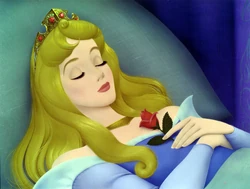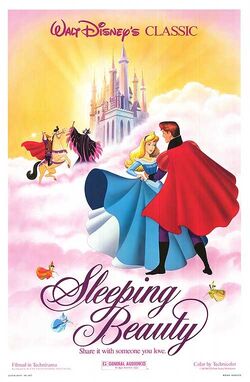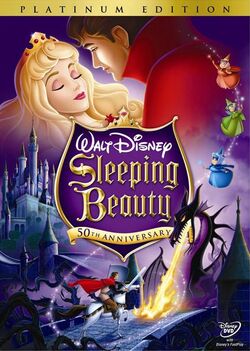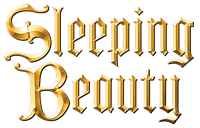Sleeping Beauty is a 1959 animated feature produced by Walt Disney Pictures and Buena Vista Distribution and originally released to theatres on January 29, 1959. The sixteenth animated feature in the Disney animated features canon, it was the last animated feature produced by Walt Disney to be based upon a fairy tale (after his death, the studio returned to the genre with The Little Mermaid), as well as the last cel animated feature from Disney to be inked by hand before the xerography process took over. Sleeping Beauty is also the first animated feature to be shot in Super Technirama 70, one of many large-format widescreen processes (only one more animated film, The Black Cauldron, has been shot in Super Technirama 70). The film spent nearly the entire decade of the 1950s in production: the story work began in 1951, voices were recorded in 1952, animation production took from 1953 until 1958, and the stereophonic musical score was recorded in 1957.
Synopsis
Princess Aurora is named after the Roman goddess of the dawn "because she fills her father and mother's lives with sunshine." While still an infant, She is betrothed to the equally-young Prince Phillip (their parents want to unite their respective kingdoms under a marriage between Aurora and Phillip). At her christening, the good fairies Flora (dressed in red), Fauna (in green) and Merryweather (in blue) arrive to bless her. Flora gives her the gift of beauty, which is described in a song as "gold of sunshine in her hair" and "lips that shame the red, red rose." Fauna gives her the gift of song. At this point, Maleficent, the film's villain and mistress of all evil, appears on the scene. Claiming to be upset at not being invited to Aurora's christening ceremony, she curses the princess to die when she pricks her finger on a spinning wheel's spindle before the sun sets on her sixteenth birthday. Fortunately, Merryweather has not yet blessed Aurora, so she uses her blessing to change Maleficent's curse, so Aurora will not die when she pricks her finger; instead, she will fall asleep until she is awakened by True Love's Kiss. Knowing Maleficent is extremely powerful and will stop at nothing to see her curse fulfilled, the three good fairies take Aurora to live with them in the woods, where they can keep her safe from any harm until she turns sixteen and the curse is made void. To fully protect her, they even change her name to Briar Rose to conceal her true identity.
Rose grows into a very beautiful woman, with sunshine golden blonde hair, rose-red lips, violet eyes, and a beautiful singing voice. She is raised in a cottage in the forest by the three fairies, whom she believes are her aunts. One day, while out picking berries, she sings to entertain her animal friends; her angelic voice gains the attention of Prince Phillip, who had grown into a handsome young man and is out riding in the woods. When they meet, they instantly fall in love. Realizing that she has to return home, Aurora flees from Phillip without ever learning his name. Despite promising to meet him again, she is unable to return, as her "aunts" choose that time to reveal the truth of her birth to her and to tell her that she is betrothed to a prince named Phillip. They then take Rose to her parents.
Meanwhile, Phillip returns home telling his father about a peasant girl he met and wishes to marry in spite of his prearranged marriage to Princess Aurora. King Hubert tries to convince Phillip to marry the princess instead of a peasant girl, but fails.

Princess Aurora, the heroine in Sleeping Beauty.
The good fairies and Aurora return to the castle. Unfortunately, Maleficent uses her magic to lure Aurora away from her chambers and up into the tallest tower of the castle, where a spinning wheel awaits her. Fascinated by the wheel, she touches the spindle, pricking her finger. As had been foretold by the curse, Aurora is put under a sleeping spell. The good fairies place Aurora on her bed with a red rose in her hand, and cause a deep sleep to fall over the entire kingdom until they can find a way to break the curse. They realize the answer is Phillip, but he has been kidnapped by Maleficent to prevent him from kissing Aurora and waking her up. The three good fairies sneak into Maleficent's lair, aid the prince in escaping and explain to him the story of Maleficent's curse. Armed with a magic sword and shield, Phillip battles Maleficent when the sorceress turns herself into a gigantic fire-breathing dragon. The sword is plunged into the dragon's heart, killing her. Phillip climbs into Aurora's chamber, and removes the curse with a kiss.
As the film ends, the two royals arrive at the ballroom, where Aurora is happily reunited with her parents. Then, Aurora dances together with Phillip, happy to each learn that their betrothed and their beloved are one and the same.
Production
Overview and art direction
The film was directed by Les Clark, Eric Larson and Wolfgang Reitherman, under the supervision of Clyde Geronimi. The script was adapted from the fairy tale Sleeping Beauty by Charles Perrault by Erdman Penner, with additional story work by Joe Rinaldi, Winston Hibler, Bill Peet, Ted Sears, Ralph Wright and Milt Banta. The film's musical score and songs are adapted from the 1890 Sleeping Beauty ballet by Pyotr Ilyich Tchaikovsky.
Sleeping Beauty holds a notable position in Disney animation as the last Disney feature to use hand-inked cels. Its art direction, which Walt Disney wanted to look like a living illustration and who was inspired by medieval art, was not in the typical Disney style. Because WDFA had already made two features based on fairy tales, Snow White and the Seven Dwarfs and Cinderella, Walt decided this film to stand out from its predecessors by choosing a different visual style. The movie eschewed the soft, rounded look of earlier Disney features for a more stylized one. Since Super Technirama 70 was used, it also meant the backgrounds could contain more detailed and complex artwork than ever used in an animated movie before.
Disney artist Eyvind Earle was the film's production designer, and Disney gave him a significant amount of freedom in designing the settings and selecting colors for the film. Earle also painted the majority of the backgrounds himself. The elaborate paintings usually took seven to ten days to paint; by contrast, a typical animation background took only one workday to complete. Disney's decision to give Earle so much artist freedom was not popular among the Disney animators, who had until Sleeping Beauty exercised some influence over the style of their characters and settings.
Characters and story development
The name of the beautiful Sleeping Beauty is "Princess Aurora" (that means sunrise in Italian, Portuguese and Spanish), in this film, as it was in the original Tchaikovsky ballet; this name occurred in Perrault's version, not as the princess's name, but as her daughter's.[1] In hiding, she is called Briar Rose, the name of the princess in the Brothers Grimm variant.[2] The prince was given the only princely name familiar to Americans in the 1950s: "Prince Phillip", named after Prince Phillip, Duke of Edinburgh. The wicked fairy goodmother was aptly named Maleficent (which means "Evil-doer").
Princess Aurora's long, thin, willowy body shape was inspired by that of Audrey Hepburn. In addition, Walt Disney had suggested that all three fairies should look alike, but veteran animators Frank Thomas and Ollie Johnston contrasted this idea saying that having them be like that wouldn't be exciting. Additionally, the idea originally included seven fairies instead of three.
Several story points for this film came from discarded ideas for Snow White. They include Maleficent's capture of the Prince and the Prince's daring escape from her castle. Disney discarded these ideas from Snow White because his artists were not able to draw a human male believably enough at the time.
Live-action reference footage
Before animation production began, every shot in the film was done in a live-action reference version, with live actors in costume serving as models for the animators. The role of Prince Phillip was modeled by Ed Kemmer, who had played Commander Buzz Corry on television's Space Patrol five years before Sleeping Beauty was released. For the final battle sequence, Kemmer was photographed on a wooden buck. Among the actresses who performed in reference footage for this film included Spring Byington, Frances Bavier and Helene Stanley who was the live reference for the title role of 1950's Cinderella.
All the live actors' performances were either screened for the animators' reference or rotscoped (traced from live-action to animation), as Walt Disney insisted that much of Sleeping Beauty's character animation be as close to live-action as possible.
Release and Reception

1990's Re-Release Poster

2008 Sleeping Beauty Re-Release DVD Cover.
Disney's distribution arm, Buena Vista Distribution, originally released Sleeping Beauty to theaters in both standard 35mm prints and large-format 70mm prints. The Super Technirama 70 prints were equipped with six-track stereophonic sound; some CinemaScope-compatible 35mm Technirama prints were released in four-track stereo, and others had monaural soundtracks. On the initial run, Sleeping Beauty was paired with the short musical/documentary film Grand Canyon which won an Academy Award.
During its original release in 1959, Sleeping Beauty earned approximately $7.7 million in box office rentals. Sleeping Beauty's production costs, which totaled $6 million, made it the most expensive Disney film up to that point, and over twice as expensive as each of the preceding three Disney animated features: Alice in Wonderland, Peter Pan, and Lady and the Tramp. The high production costs of Sleeping Beauty, coupled with the under performance of much of the rest of Disney's 1959–1960 release slate resulted in the company posting its first annual loss in a decade for fiscal year 1960, and massive layoffs were done throughout the animation department.
The film was met with mixed reviews from critics, often citing the film being slowly paced and having little character development. Nevertheless, the film has sustained a strong following and is today hailed as one of the best animated films ever made, thanks to its stylized designs by painter Eyvind Earke who also was the art director for the film, its lush music score and its large-format 70mm widescreen and stereophonic sound presentation.
Rotten Tomatoes gave the film a "Certified Fresh" 91% from 34 reviews with an average rating of 7.7/10. Its consensus states that "This Disney dreamscape contains moments of grandeur, with its lush colors, magical air, one of the most menacing villains in the Disney canon."
Carrie R. Wheadon of Common Sense Media gave the film five out of five stars, writing, "Disney classic is delightful but sometimes scary".
Like Alice in Wonderland, which was not initially successful either, Sleeping Beauty was never re-released theatrically in Walt Disney's lifetime. However, it had many re-releases in theaters over the decades. The film was re-released theatrically in 1970, 1979 (in 70mm 6 channel stereo, as well as in 35 mm stereo and mono), 1986, 1993, and 1995. Sleeping Beauty's successful reissues have made it the second most successful film released in 1959, second to Ben-Hur, with a lifetime gross of $51.6 million. When adjusted for ticket price inflation, the domestic total gross comes out to $478.22 million, placing it in the top 40 of films.
Home Video
In 1986, it was first released on both VHS and Laserdisc under the Classics collection, becoming the first Disney Classics video to be digitally processed in Hi-Fi stereo. Then the film underwent an extensive digital restoration in 1997, and that version was released to both VHS and Laserdisc again as part of the Masterpiece collection, and in 2003 was released to DVD in a 2-disc "Special Edition" that included both the original widescreen version and a pan and scan version as well. A Platinum Edition DVD/Blu-ray Disc was released on October 7, 2008 with a never-before seen 2.55:1 expanded version of the film. The DVD/Blu-ray returned to the Disney Vault in 2010. The film is expected to appear in the Diamond Edition in Fall 2014.
- October 1986 (Walt Disney Classics - VHS and Laserdisc)
- August 1990 (Abril Vídeo/Walt Disney Home Video - VHS - Brazilian Original Version)
- November 1996 (Abril Vídeo/Walt Disney Home Video - VHS - 1st Brazilian Reissue remastered version)
- March 1997 (Walt Disney Masterpiece Collection - VHS)
- June 2002 (Walt Disney Home Entertainment - VHS and DVD - 2nd Brazilian re-release restored version)
- September 2003 (Special Edition - Walt Disney Home Entertainment - VHS and DVD)
- October 7, 2008 (Platinum Edition - Walt Disney Studios Home Entertainment - DVD and Blu-ray Disc)
- October 2008 (Walt Disney Studios Home Entertainment - DVD and Blu-ray Disc - 3rd Brazilian re-release restored in High Definition version)
Sleeping Beauty release history
- January 29, 1959 (original release)
- June 10, 1970
- September 28, 1979
- March 7, 1986
- April 16, 1993
- September 8, 1995 (restored and remastered)
Worldwide release dates
- Brazil: February 6, 1959
- Argentina: July 9, 1959
- UK: July 29, 1959
- West Germany: October 30, 1959
- Italy: December 1, 1959
- France: December 16, 1959
- Netherlands: December 17, 1959 (English language version)
- Finland: December 18, 1959
- Sweden: December 19, 1959
- Australia: December 24, 1959
- Mexico: December 24, 1959
- Denmark: December 26, 1959
- Norway: December 26, 1959
- Austria: January 15, 1960
- Netherlands: April 14, 1960 (Dutch language version)
- Hong Kong: May 26, 1960
- Japan: July 23, 1960
- Spain: October 3, 1960 (Madrid)
- Portugal: April 2, 1961
- Turkey: April 23, 1962
- Hungary: June 30, 1966
- East Germany: October 10, 1969
- Poland: August 18, 1995
- Kuwait: May 24, 1999
Voice Cast
| Actor | Role(s) |
|---|---|
| Mary Costa | Princess Aurora/Briar Rose |
| Eleanor Audley | Maleficent |
| Verna Felton | Flora Queen Leah |
| Barbara Luddy | Merryweather |
| Barbara Jo Allen | Fauna |
| Bill Shirley | Prince Phillip |
| Taylor Holmes | King Stefan |
| Bill Thompson | King Hubert |
| Dallas McKennon | The Owl |
| Marvin Miller | The Narrator |
| Bill Amsbery | Maleficent's Goon # 1 |
| Candy Candido | Maleficent's Goon # 2 |
| Pinto Colvig | Maleficent's Goon # 3 |
| Thurl Ravenscroft | Singer |
Directing Animators
- Milt Kahl (Prince Phillip, King Hubert)
- Frank Thomas (Flora, Fauna, Merryweather)
- Ollie Johnston (Flora, Fauna, Merryweather)
- Marc Davis (Aurora, Maleficent)
- John Lounsbery (King Stefan, King Hubert, The Queen)
Titles in different languages
- Albanian: Bukuroshja e Fjetur
- Arabic: الجميلة النائمة
- Bosnian: Trnoružica (The Briar-Rose); Uspavana ljepotica (Sleeping Beauty)
- Bulgarian: Спящата красавица (The Sleeping Beauty)
- Catalan: La Bella Dorment
- Croatian: Trnoružica (The Briar-Rose); Uspavana ljepotica (Sleeping Beauty)
- Chinese: 睡美人 shùi měirén (Sleeping Beauty)
- Danish: Tornerose
- Dutch: Doornroosje
- Estonian: Okasroosike
- Finnish: Prinsessa Ruusunen
- French: La Belle Au Bois Dormant
- German: Dornröschen (also Dornröschen und der Prinz)
- Greek: Η Ωραία Κοιμωμένη
- Hebrew: היפהפיה הנרדמת
- Icelandic: Þyrnirós
- Indonesian: Putri Tidur
- Italian: La Bella Addormentata nel Bosco
- Japanese: 眠れる森の美女 (Nemureru Mori No Bijo)
- Korean: 잠자는 숲속의 공주
- Vietnamese: Công Chúa Ngủ trong Rừng
- Latvian: Aizmigusī Princese
- Macedonian: Заспаната убавица
- Maltese: Is-Sbejħa Riqda
- Norwegian: Tornerose
- Persian: زیبای خفته
- Polish: Śpiąca Królewna (lit. Sleeping Princess)
- Portuguese: A Bela Adormecida
- Romanian: Frumoasa din pădurea adormită
- Russian: Спящая красавица
- Serbian: Uspavana lepotica (Cyrilic:Успавана лепотица)
- Spanish: La Bella Durmiente
- Swedish: Törnrosa
- Thai: เจ้าหญิงนิทรา
- Turkish: Uyuyan Güzel
- Hungarian: Csipkerózsika
Sleeping Beauty in the Disney theme parks
Sleeping Beauty was made whilst Walt Disney was building Disneyland (hence the four year production time). To help promote the film, Imagineers declared the castle there to be Sleeping Beauty's (it was originally to be Snow White's).
Several years later an indoor walkthrough section was added to the castle, where guests could walk through dioramas of scenes from the film. It closed shortly after September 11, 2001, supposedly because the dark, unmonitored corridors were a risk. The attraction reopened in 2008 with dioramas that are very similar to the original ones buth with new technology.
When Disneyland Paris opened in 1992 it also featured Sleeping Beauty's Castle, this time a far more romanticised, storybook building. Upstairs guests are able to view stained glass windows and tapestries telling the story, whilst downstairs they are able to view an animatronic dragon.
Hong Kong Disneyland opened in 2005 also with a Sleeping Beauty Castle, with a fairly similar design to Disneyland's.
Princess Aurora (and, to a lesser extent, Prince Phillip and Maleficent) makes regular appearances in the parks and parades.
Voices
- The studios have no record as to who provided the voice for the queen, Aurora's mother.
- Barbara Jo Allen (Fauna) was also known in some of her other film work as Vera Vague.
- A flame thrower was used to create the dragon breath sound effect for the climax of the movie, with training films supplied by the US Army.
- Barbara Luddy, who is the voice of Merryweather (Blue Fairy), lent her voice to Lady in the earlier Disney movie Lady and the Tramp. After Sleeping Beauty, she would also end up being the voices of Mother Rabbit in Robin Hood and Kanga in The Many Adventures of Winnie the Pooh.
- Eleanor Audley, who voices Maleficent, also provided the voice of Lady Tremaine in Cinderella nine years earlier.
- Verna Felton (Flora) perviously lent her voice to The Elephant Matriarch and Mrs. Jumbo in Dumbo, The Fairy Godmother in Cinderella, The Queen of Hearts in Alice in Wonderland and Aunt Sarah in Lady and the Tramp. After Sleeping Beauty her last film for Disney was providing the voice for Winnifred in The Jungle Book.
Trivia
- Briar Rose is another name given to Sleeping Beauty and appears in the German version of the story.
- Instead of a certain day, Maleficent's curse has a 16-year time period to be fulfilled.
- Although there are no blatantly comical characters in the movie (like the mice in Cinderella) the parents of the Princess Aurora and Prince Phillip serve as mild comic relief. Including parents in the film was also an unusual addition.
- Aurora is one of the seven Princesses of Heart in the popular Square Enix game Kingdom Hearts, and Maleficent is a villain in all three Kingdom Hearts games. The good fairies appear in Kingdom Hearts II, giving Sora new clothes.
- Aurora's mother, the queen as a character, has no name credited to her. The only version of the story which gives her a name is a 1993 adaptation by A.L. Singer, where she is named Queen Leah.
- The movie was quite similar to Rich Animation Studio's animated film "The Swan Princess", which had a princess cursed by a sorcerer (just like Maleficent cursed Aurora). In the end, the princess died temporarily (like Aurora fell in a deep sleep) and a prince saved her by killing the sorcerer, whom had turned into a huge bat (just like Maleficent morphed into a dragon and Prince Phillip killed her and saved the princess with "True Love's Kiss").
- The cookies the fairies eat with tea are shaped like Mickey Mouse's head and ears.
- Second only to Dumbo (who didn't speak at all), this Disney title character has very few lines of actual dialogue throughout the entire film. In fact, Aurora says nothing at all in the film's second half, even after being awakened from the sleeping spell.
- The musical score throughout the film was provided by the Berlin Symphony Orchestra.
- The complex and detailed background paintings, most of them done by Frank Armitage and Eyvind Earle usually took seven to ten times longer to paint than average, which takes about a workday to complete. As opposed to having the backgrounds be designed to match the characters, Sleeping Beauty's characters were designed to match the backgrounds.
- Sleeping Beauty is the only Disney movie with square trees.
- The moment where Aurora pricks her finger as well as the fight of Prince Phillip with Malificent are referenced in the Nightwish song FantasMic, with the lyrics "Maleficent's fury /The spindle so luring/Dragon fight".
- Upon release, the scene where Prince Phillip encounters the dragon was thought too intense for children.
- The original concept for Sleeping Beauty began in 1950 (after having animated two other princess fairy tales). Work on the film was delayed because Walt's attention was turned to the building of Disneyland.
- Walt Disney had originally envisioned Sleeping Beauty as his masterpiece.
- Because Sleeping Beauty was such a box office disappointment, Disney focused more on live-action films for two years (there were ten before Disney released another animated feature - 101 Dalmatians. The style of animation in this film was radically different possibly because Sleeping Beauty had been such a failure).
Errors and Goofs
- When Maleficent reveals Aurora's body to the good fairies, Aurora is drawn to appear as if her neck was broken. In later shots, her neck is stable.
- The royal couple dances a waltz during the forest scene, and at the end of the film. However, the film takes place in the 14th century, and the waltz was not invented until the 18th century.
- During most of the movie, Aurora has a different skin color on her legs, most noticeably in her peasant state.
Videos
Gallery
Soundtrack listing
The Sleeping Beauty Official Soundtrack.
- Main Title/Once Upon a Dream/Prologue
- Hail to the Princess Aurora
- The Gifts of Beauty and Song/Maleficent Appears/True Love Conquers All
- The Burning of the Spinning Wheels/The Fairies Plan
- Maleficent's Frustration
- A Cottage in the Woods
- Do You Hear That?/I Wonder
- An Unusual Prince/Once Upon a Dream
- Magical House Cleaning/Blue or Pink
- A Secret Revealed
- Skumps (Drinking Song)/The Royal Argument
- Prince Phillip Arrives/How to Tell Stefan
- Aurora's Return/Maleficent's Evil Spell
- Poor Aurora/Sleeping Beauty
- Forbidden Mountain
- A Fairy Tale Come True
- Battle with the Forces of Evil
- Awakening
- Finale
References in other media
- The film was referenced in Dan Brown's The Da Vinci Code as an allegory of the grail quest.
- The music to the song Once Upon a Dream is from the Pyotr Ilyich Tchaikovsky ballet Sleeping Beauty, as is almost all the rest of the music in the film. The music to the song was also used in recent commercials for Sargento Cheese as well as a couple of Fred Quimby era Tom & Jerry cartoons.
- The sleep spell was spoofed on Hanna Barbera's The 13 Ghosts of Scooby-Doo in 1985 in which Scooby Doo must save Daphne Blake and Princess Esmerelda from this spell caused by Maldor the Malevolent. Interestingly, Daphne wore a similar outfit to what Aurora wore in a What's New Scooby-Doo? episode.
References
- ↑ Heidi Anne Heiner, "The Annotated Sleeping Beauty"
- ↑ Jacob and Wilheim Grimm, Grimm's Fairy Tales, "Briar Rose"
External links
- Template:Imdb title
- Sleeping Beauty in the Big Cartoon DataBase
| v - e - d | ||||||||||||||||
|---|---|---|---|---|---|---|---|---|---|---|---|---|---|---|---|---|
|
Template:Animated Feature-nav
| This page uses content from the English Wikipedia page Sleeping Beauty. The list of authors can be seen in the page history. Text from Wikipedia is available under the Creative Commons Attribution-ShareAlike License; additional terms may apply. |





